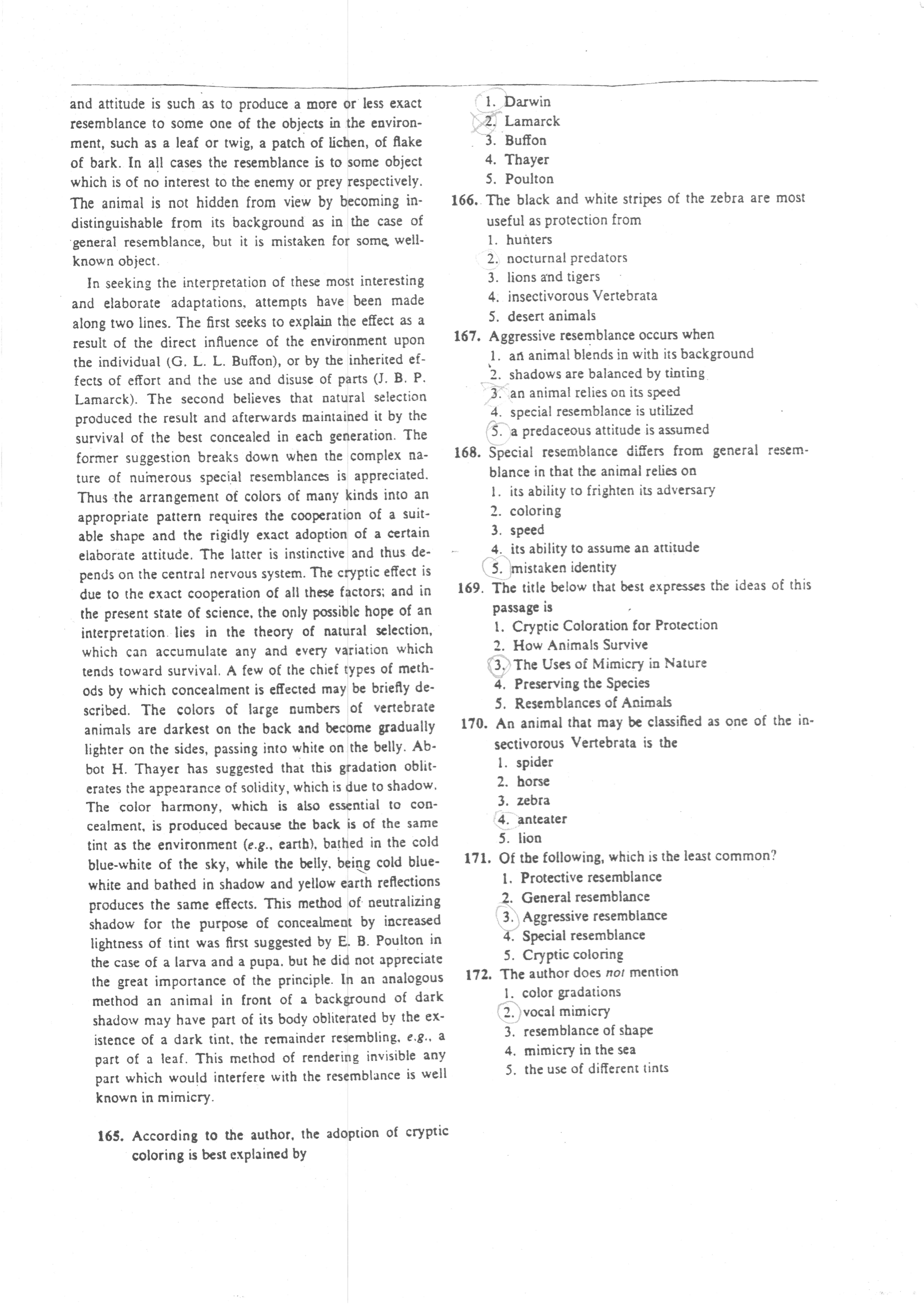czytanie teksty (10)

and attitude is such as to produce a morę or less exact resemblance to some one of the objects in the environ-ment, such as a leaf or twig, a patch of lichen, of fiake of bark. In all cases the resemblance is to some object which is of no interest to the enemy or prey respectively. The animal is not hidden from view by becoming in-distinguishable from its background as in the case of generał resemblance, but it is mistaken for some, well-known object.
In seeking the interpretation of these most interesting and eiaborate adaptations, attempts have been madę along two lines. The first seeks to explain the effect as a result of the direct influence of the environment upon the individual (G. L. L. Buffon), or by the inherited ef-fects of efTort and the use and disuse of parts (J. B. P. Lamarck). The second believes that natura! selection produced the result and afterwards maintained it by the survival of the best concealed in each generation. The former suggestion breaks down when the complex naturę of numerous speciał resemblances is appreciated. Thus the arrangement of colors of many kinds into an appropriate pattern reąuires the cooperation of a suit-able shape and the rigidly exact adoption of a certain eiaborate attitude. The latter is instinctive and thus de-pends on the central nervous system. The cryptic effect is due to the exact cooperation of all these factors; and in the present State of science, the only possiblc hope of an interpretation lies in the theory of natural selection, which can accumulate any and every variation which tends toward survival. A few of the chief types of meth-ods by which concealment is effected may be briefly de-scribed. The colors of large numbers of vertebrate animals are darkest on the back and become gradually lighter on the sides, passing into white on the belly. Ab-bot H. Thayer has suggested that this gradation oblit-erates the appearance of solidity, which is due to shadow. The color harmony, which is also essential to concealment, is produced because the back is of the same tint as the environment (e.g., earth). bathed in the cold blue-white of the sky, while the belly, being cold blue-white and bathed in shadow and yellow earth reflections produces the same effects. This method of neutralizing shadow for the purpose of concealment by increased lightness of tint was first suggested by E. B. Poulton in the case of a larva and a pupa. but he did not appreciate the great importance of the principle. In an analogous method an animal in front of a background of dark shadow may have part of its body obliterated by the ex-istence of a dark tint, the remainder resembling, e,g., a part of a leaf. This method of rendering invisible any part which would interfere with the resemblance is well known in mimicry.
165. According to the author, the adoption of cryptic coloring is best expiained by
1. Darwin
2. Lamarck
3. Buffon
4. Thayer
5. Poulton
166. The black and white stripes of the zebra are most useful as protection from
1. huńters
2. nocturnal predators
3. lions and tigers
4. insectivorous Vertebrata
5. desert animals
167. Aggressive resemblance occurs when
1. art animal blends in with its background
2. shadows are balanced by timing
3. an animal relies on its speed
4. special resemblance is utiiized
5. a predaceous attitude is assumed
168. Special resemblance differs from generał resemblance in that the animal relies on
1. its ability to frighten its adversary
2. coloring
3. speed
4. its ability to assume an attitude
5. mistaken identity
169. The title below that best expresses the ideas of this passage is
1. Cryptic Coloration for Protection
2. How Animals Survive
3. The Uses of Mimicry in Naturę
4. Preserving the Species
5. Resemblances of Animals
170. An animal that may be classified as one of the in-sectivorou$ Vertebrata is the
1. spider
2. horse
3. zebra
4. anteater
5. lion
171. Of the foilowing, which is the least common?
I. Protective resemblance
JL General resemblance
3. Aggressive resemblance
4. Special resemblance
5. Cryptic coloring
172. The author does not mention
1. color gradations
2. vocal mimicry
3. resemblance of shape
4. mimicry in the sea
5. the use of different tints
Wyszukiwarka
Podobne podstrony:
041 (10) chapter three things to wea r One of the fun things about felting wearables is that you can
Shuttle Tatting Without A Teacher (14) WE have discussed and demonstrated what is consid-ered to be
Huff method is thought to be one of the most often used models which takes into consideration the la
Information Advisory Sub-Committee by its Chairman (who was asked to include one of the German
s&h 125 STRBNGTH ANI) H1SALTH 12ó CHEST AND P.ACK—No. 1 I am not nlone in beliering tliis to be one
s&h 125 STRBNGTH ANI) H1SALTH 12ó CHEST AND P.ACK—No. 1 I am not nlone in beliering tliis to be one
sints)24 26 and oxygen species such as hydrogen peroxide and supercnade.27*28 Heat resistance An ear
4?PRE-ALGEBRA: Quiz 8.2 - Answer Key 1. Which of the points (-2, 12), (-1, 12), (3, -10), and (-2, 1
ARCHMELOG and NOARCHIVELOG Modę One of the important decisions you nced to make as a DBA is to deter
What is meant by enzyme and what is its criteria to be used as diagnostic tool in clinical path
BRIOUETTE "Fuel Briquettes - madę from everyday agricultural and commercial residues such as we
image002 Brian Aldiss is one the most influential -and one of the best - SF writers Britain has eve
image002 “There has never been a collection like this before” James Blish. . . and there hasn’t. Thi
więcej podobnych podstron